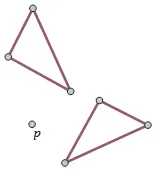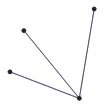![]()
Geometry by Construction
Chapter 1
Euclidean geometry rules and constructions
Since our two-dimensional versions of bent space require Euclidean geometry, we will start with that geometry. Here’s a brief review of the geometry of Pythagoras, Newton and Kant: Euclidean geometry. When the time comes, we will see that the bent geometries have the same logical standing as Euclidean. In fact, we will study the bent spaces in terms of Euclidean, sort of like astronauts who work in orbit: some Earthly rules apply while others do not apply.
These pages of rules and constructions are absolutely essential knowledge for this book. We will explore many of those rules. We will also refer to rules as if they are familiar, even if they have not turned up in any previous problems.
1.1 Euclidean Geometry Vocabulary and Definitions
Learn these quickly and never get them mixed up.
Point: That which has no size; it has zero dimensions. A point is pure location.
Line: The set of points which lie between two distinct points and the points included when the segment is extended. When the segment is extended in only one direction, this makes a ray. Lines, segments and rays are one dimensional. Points on a single line are called collinear.
Plane: The set of all points on two intersecting lines, along with the points between any two points, one on each line. A plane is two dimensional. Points in the same plane are called coplanar.
Between: Point B lies between points A and C if the distance from A to B plus the distance from B to C equals the distance from A to C.
Isometries
An isometry is a transformation which preserves distances and angle measures.
Reflection: Reflect across a line. The line acts as a mirror. The reflection sends each point to the point on the line perpendicular to the line of reflection, at the same distance from the line of reflection as the starting point. Usage: Ref l (object) where l is the line of reflection and object is the object being reflected. This is the only basic isometry which reverses orientation.
Translation: Move the object in the plane. All points have their x and y coordinates changed by the same two amounts. Usage: f (x, y) = (a + x, b + y).
Rotation: Rotate an object around a point by an angle of a certain size. Usage: Rot(P, θ, object) where P is the point around which the rotation occurs and θ is the angle of rotation.
Special Lines
Notation: We will use the nouns segment, ray and line before two letters to indicate which object we mean. The length of the segment, AB, has no modifier and this indicates a number.
Parallel: Coplanar lines which have no intersection are parallel.
Perpendicular: Lines which meet at right angles are perpendicular.
Segment Bisector: A line containing the midpoint of a segment.
Angle Bisector: A line through the vertex of an angle which divides the angle into two congruent angles.
Angle: Two rays, a ray and a segment or two segments joined at an endpoint (called the vertex) form a set of points called an angle. We define 360 degrees as the rotation of one ray around its end point exactly once; so one degree is 1/360 of a complete rotation.
Special Angles
These angles get their names from their positions.
Adjacent: Two angles with the same vertex and one shared side, but with no interior points in common.
Vertical: Two intersecting lines form two pairs of equal angles. Each pair is vertical. They form a letter X-shape.
The following special angle positions occur when two lines are crossed by a transversal.
Corresponding: This pair are in the same relative position, as in both being upper right. A pair of these form an F shape. The two lines cut by the transversal are parallel if and only if corresponding angles are congruent.
Alternate Interior: Their sides form a Z-shape. The two lines cut by the transversal are parallel if and only if the alternate interior angles are equal.
Alternate Exterior: These angles are vertical with a pair of alternate interior angles.
The two lines cut by the transversal are parallel if and only if the alternate exterior angles are equal.
Same-side Interior: These angles form a block C-shape.
The two lines cut by the transversal are parallel if and only if the same-side interior angles are supplementary.
Same-side Exterior: These angles are adjacent to a pair of same-side interior angles.
The two lines cut by the transversal are parallel if and only if the same-side exterior angles are supplementary.
Supplementary: Two angles are supplementary when their angle measures add up to 180 degrees.
A special case of supplementary angles: Adjacent angles with collinear exterior sides are supplementary. These are sometimes called a linear pair.
Complementary: Two angles are complementary when their angle measures add up to 90 degrees.
A special case of complementary angles: Adjacent angles with perpendicular exterior sides are complementary.
External Angle: When one side of a polygon is extended, the angle formed by the extended side and next side of the polygon is an external angle. In a triangle, an external angle is equal to the sum of the remote interior angles (the two interior angles which are not adjacent to the exterior angle.)
Straight Angle: An angle whose measure is 180 degrees is a straight angle. The exterior sides form a line.
Obtuse Angle: An angle whose measure is between 90 and 180 degrees.
Right angle: An angle whose measure is 90 degrees is a right angle.
Acute Angle: An angle whose measure is less than 90 degrees is an acute angle.
Bisectors
Perpendicular Bisector of a segment: A line, ray, or segment which is perpendicular to a segment at that segment’s midpoint is a perpendicular bisector of a segment.
Angle Bisector: A line which cuts an angle into two equal angles is an angle bisector. Any point on an angle bisector is equ...














